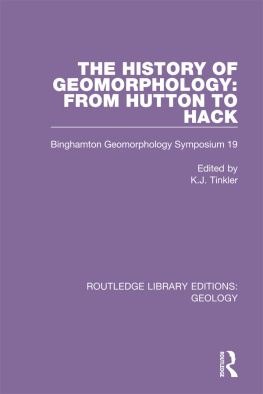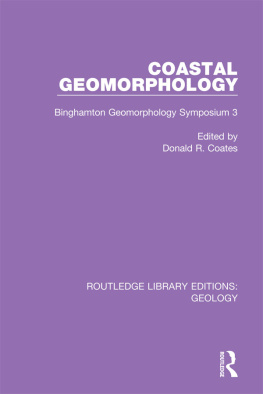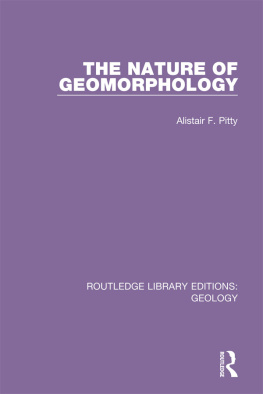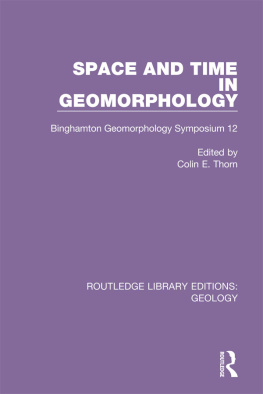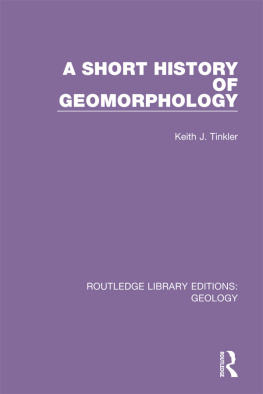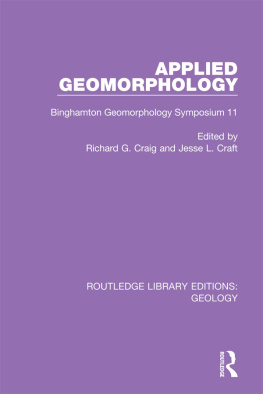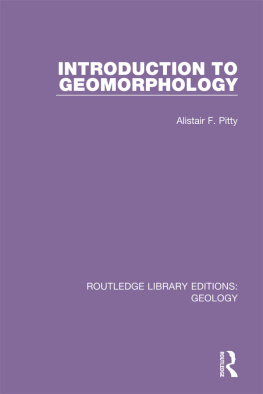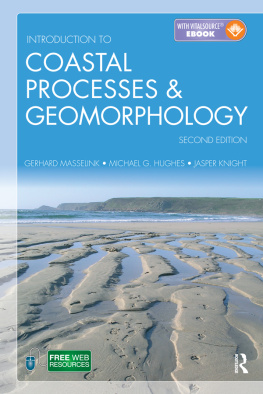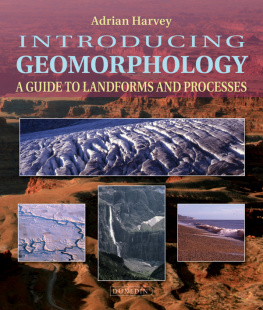Contents
Guide
Print Page Numbers

ROUTLEDGE LIBRARY EDITIONS:
GEOLOGY
Volume 20
THE HISTORY OF
GEOMORPHOLOGY:
FROM HUTTON TO HACK
THE HISTORY OF
GEOMORPHOLOGY:
FROM HUTTON TO HACK
Binghamton Geomorphology Symposium 19
Edited by
K.J. TINKLER

First published in 1989 by Unwin Hyman, Inc.
This edition first published in 2020
by Routledge
2 Park Square, Milton Park, Abingdon, Oxon OX14 4RN
and by Routledge
52 Vanderbilt Avenue, New York, NY 10017
Routledge is an imprint of the Taylor & Francis Group, an informa business
1989 K.J. Tinkler & contributors
All rights reserved. No part of this book may be reprinted or reproduced or utilised in any form or by any electronic, mechanical, or other means, now known or hereafter invented, including photocopying and recording, or in any information storage or retrieval system, without permission in writing from the publishers.
Trademark notice: Product or corporate names may be trademarks or registered trademarks, and are used only for identification and explanation without intent to infringe.
British Library Cataloguing in Publication Data
A catalogue record for this book is available from the British Library
ISBN: 978-0-367-18559-6 (Set)
ISBN: 978-0-429-19681-2 (Set) (ebk)
ISBN: 978-0-367-46449-3 (Volume 20) (hbk)
ISBN: 978-1-00-302889-5 (Volume 20) (ebk)
Publishers Note
The publisher has gone to great lengths to ensure the quality of this reprint but points out that some imperfections in the original copies may be apparent.
Disclaimer
The publisher has made every effort to trace copyright holders and would welcome correspondence from those they have been unable to trace.
History of
Geomorphology
From Hutton to Hack
Edited by
K.J. Tinkler
The Binghamton Symposia in Geomorphology:
International Series, no.19
Boston
UNWIN HYMAN
London Sydney Willington
K. J. Tinkler & contributors, 1989
This book is copyright under the Berne Convention. No reproduction without permission. All rights reserved.
This book was typeset, proofed, and passed for press by the editor and contributors.
Unwin Hyman, Inc.,
8 Winchester Place, Winchester, Mass. 01890, USA
Published by the Academic Division of
Unwin Hyman Ltd
15/17 Broadwick Street, London W1V 1FP, UK
Allen & Unwin (Australia) Ltd,
8 Napier Street, North Sydney,
NSW 2060, Australia
Allen & Unwin (New Zealand) Ltd in association with the Port Nicholson Press Ltd,
Compusales Building, 75 Ghuznee Street, Wellington 1, New Zealand
First published in 1989
Library of Congress Cataloging in Publication Data
The history of geomorphology: from Hutton to Hack / edited by
Keith J. Tinkler.
p. cm. (The Binghamton symposia in geomorphology; no. 19)
Proceedings of the 19th Annual Binghamton Geomorphology Symposium Pref.
Includes bibliographical references.
ISBN 0-04-551138-1
1. Geomorphology History Congresses. I. Tinkler, K. J., 1942 . II. Binghamton Geomorphology Symposium (19th: 1988: Binghamton, N.Y.) III. Series.
GB400.7.H57 1989
551.4l09-dc20 89-16594
CIP
British Library Cataloguing in Publication Data
The history of geomorphology. (The Binghamton symposia.
International series; 19)
1. Geomorphology, history
I. Tinkler, Keith J. II. Series
551.409
ISBN 0-04551138-1
Printed in Great Britain by The University Press, Cambridge.
Contents
TERRA INCOGNITA
it will be some time before . historians and philosophers awaken from their dogmatic slumbers and see the history of geology as an area with broad implications for the study of science generally.
(M.T. Greene, 1985, p. 97.)
It is a great pleasure to present this book, the proceedings of the Nineteenth Annual Binghamton Symposium, to the geomorphological public to commemorate and honour both the publication of James Huttons extended essay Theory of the Earth in the 1788 Transactions of the Royal Society of Edinburgh (their very first volume), and the twentieth century career of John Hack of the United States Geological Survey, whose particular contribution to geomorphology has been an explicit formulation of an equilibrium theory of landscape development (Hack 1960). Although Hack is approximately two centuries later than Hutton eighteenth century geologists, especially in Britain, might not have been surprised to read a theory committed to viewing landscape as a state of equilibrium achieved within a system of competing forces, as I hope I demonstrate in my own essay (Chapter 3).
I am convinced that it constitutes a volume worthy of both individuals for it is the first set of essays whose determined focus is the history of geomorphology, although it is by no means the first book on the history of geomorphology. For good measure those few of us who have written books on the history of the discipline (and many of whom were at the Symposium) are frequently taken to task in this volume for having neglected substantial fields and significant areas of concern! We can all retort that nothing in our own essays can be found in our books, and that surely is very satisfactory!
At present geomorphology is showing signs of out-growing a lengthy adolescence and may soon adopt a formal international structure which will be both independent of, and competitive with, similar structures in geography and geology to which its parent bodies belong. This move is likely to be seen as one of great significance by those involved in its organisation and by many beyond it, and it may well signal structural changes within the discipline whose actual outcome and meaning will not be clear for several decades.
My perspective on such a move is cool, because the adoption of an historical perspective with respect to the practice of geomorphology in times past brings the recognition that times present are in no sense different. That which seems appropriate, fundable, official and achievable is just that: the essays of Stoddart (Chapter 8) and Hewitt (Chapter 9) both neatly illustrate, in their different ways, the distinction between official and scientific approaches to the same problem. But institutional expansion, Viteks paper not withstanding (Chapter 14), may not be why our geomorphology will be of interest to future generations. What that interest will be is a matter for speculation. Will it be contemporary interplanetary equivalents of the great explorations of the nineteenth centuries? Will it be our ability to collect vast quantities of real-time process data, and to manipulate it with mathematical models and GIS systems, on computers whose memory capacity is already outgrowing our imagination? Might it be that we have achieved disciplinary consciousness and have begun to write histories of ourselves? Or will it be our realisation that despite an almost total failure to communicate significant quantities of information between major language groups, we have nevertheless managed to muddle our way to a reasonably coherent picture of how the worlds surface works? (see, for example, Starkels essay, Chapter 12) We cannot know: if we did we could be prophets. We must keep an open mind, and we should read the opening essay by Gordon Herries Davies not just for its splendid rhetoric, but to realise that its logic is irrefutable.

